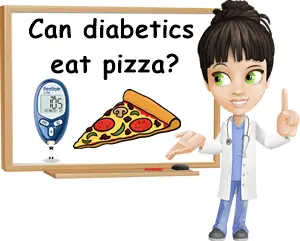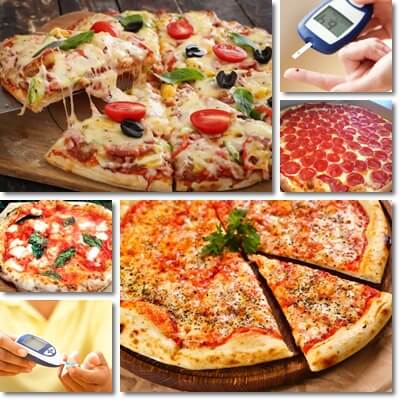If you’re diabetic, you may have been wondering if it’s okay to eat pizza with your condition or if it’s bad for you and to what extent. The truth is, the effect pizza has on diabetes is variable and depends on multiple factors, including intake (how much you eat at once), frequency (how often – is it a common choice of a meal for you or more like an occasional treat?), crust thickness and choice of toppings.
Eating pizza with diabetes is generally advised against. Whether you have diabetes type 2 or type 1, it is not a healthy meal choice both short and long term. At most, the fast food is tolerated in very small amounts of the likes of one slice (tops) and only as an occasional treat – so small servings and infrequent intake. And there really isn’t such a thing as a pizza diabetics can eat, unless it’s not the real thing but a look-alike food that merely imitates its appearance but definitely not the rich taste experience.

How bad is pizza for diabetics?
First of all, it’s too rich in carbohydrates which are broken down into simple sugars and contribute to blood sugar levels. Of course, fats and protein from cheese and meat used as toppings and fiber from vegetables delay digestion and prevent immediate rises in blood sugar levels. But the carbohydrates in the crust, tomato sauce and various vegetable or fruit toppings (tomatoes, peppers, mushrooms, green beans, corn, pineapple etc.) do add up to your intake of carbs per day and per meal. And pizza dough may also have added sugar to help it brown more beautifully.
Dietitians estimated that a slice of pizza about the size of the palm of your hand can provide around 30 g of carbohydrates. The thicker the crust and topping, the higher the carbohydrate content. The thinner the crust and topping, the lower the carbohydrate content. Since diabetics are advised to eat a maximum of 45-60 g of carbohydrates per meal, a single slice covers half or 3/4 of your intake, which is a lot. Not to mention that almost nobody eats just one slice, but at least two or three. And a slice is nowhere close to a satiating, fulfilling meal; if anything, it leaves you wanting to eat more.
Secondly, pizza is rich in fat from its main toppings, cheese and meat. Cheeses like mozzarella or cold meats like salami are significant sources of fat, half of which is usually saturated. Some of the most popular cheese topping choices include mozzarella, provolone, cheddar, Parmesan, but also Emmentaler, Romano, Gorgonzola, other blue cheeses, goat cheese and ricotta. Favorite meat toppings include cold meats such as salami, sausages, ham, prosciutto, chorizo, ground beef, fish and seafood.

Pizza cheeses fat content
To better put things into perspective, here is the fat content of several preferred pizza cheeses:
1) The original pizza cheese, whole milk mozzarella, provides an average of 22 g of fat per 100 g, 13 g of which are saturated fats. Also learn about the surprising benefits of mozzarella cheese.
2) Provolone cheese has over 26.6 g of fat per 100 g.
3) Reduced-fat provolone has 17.6 g of fat per 100 g.
4) Cheddar has 33.8 g of fat per 100 g. A single slice of cheddar estimated at 28 g (1 oz) has 9.5 g of fat.
5) Low fat cheddar has 7 g of fat per 100 g.
Of course, the average food establishment will use the full-fat versions, combinations of several types of cheese or processed versions rich in vegetable oils. Not to mention that some of these aged cheeses along with cold meats further add too much sodium to a diabetic diet. So eating pizza too often or in too large amounts can lead to both weight gain and hypertension in diabetes or accentuate these existing issues.
The only advantage to fat and protein in the cheese and meat pizza toppings is that they slow down digestion and the resulting nutrient absorption process. This means that the sugars from the carbohydrates in the crust and vegetable or fruit toppings won’t get absorbed right away so you won’t experience sudden and almost instant rises in blood sugar levels.
Surges in blood sugar after eating pizza
But even so, some diabetics report surges in blood sugar hours after eating pizza. How is this possible? Well, the fat, protein and fiber in the various ingredients slow down digestion and nutrient absorption, including that of sugar. But all of the nutrients obtained from pizza eventually get absorbed and this happens roughly at about the same time, even if hours after eating.
And because the crust and vegetable toppings represent a significant source of carbohydrates, you get a surge in blood sugar levels. The more pizza you eat (even if only 2-3 slices), the more likely it will make your blood sugar go up high, even if longer after eating. Remember that the thicker crust and topping (vegetables and fruits), the more carbohydrates in your slice of pizza. For example, a 60 g cup of tomato sauce provides 4 g of carbohydrates on average.
So how is eating pizza bad for diabetes?
Here are the reasons why it’s best avoided and the side effects it may cause:
1) It’s a significant source of carbohydrates and adds to your intake per day and per meal.
2) It may cause spikes in blood sugar levels hours after eating.
3) Too high in fat from cheese and meat toppings – promotes weight gain.
4) Cheese, cold meats, anchovies, olives in brine, capers and added salt boost sodium intake and promote hypertension and water retention.
5) It’s too heavy on the stomach and can lead to acid reflux if you eat too much. Feelings of sluggishness and bloating may occur as well.
6) Regular consumption causes high cholesterol and cardiovascular disease.
Best pizza crust and sauce recipes for diabetics?
Remember that there are no ideal diabetes recipes for pizza crust or sauce to make them friendlier options for those with the condition. The food itself is high in carbs, laden with fat and usually also rich in sodium. And these are the things we most love about it. And it’s what makes pizza so good, and frankly, what it is. Even if it means it’s not a good food to eat with diabetes.
How to eat pizza with diabetes
At most, diabetics can eat pizza infrequently, in small amounts of the likes of one slice and preferably no more than one serving a day. It’s best to avoid eating it at night and opt for it as a lunchtime treat instead. If possible, walk it out. Go for thin-crusted pizza instead of thick-crusted one. Choose whole tomatoes instead of tomato sauce and non-fat or low fat cheese instead of whole milk cheese to reduce fat content and energetic value.
If you’re dealing with high blood pressure, then know that low fat fresh mozzarella, ricotta or goat cheeses are better options than aged cheddar, provolone or Parmesan as they are naturally low in sodium. For diabetes-associated hypertension, also avoid toppings like olives in brine, capers, curry mixes, anchovies, canned tuna and cold meats. Opt for chicken and fresh vegetables instead (sun dried tomatoes, arugula, spinach, patience dock, mushrooms, artichoke, green beans, sweet and chili peppers, garlic, onions or figs and pineapple. White pizza is also a relatively good option as it has just a thin crust, olive oil and herbs of your choosing as toppings.
